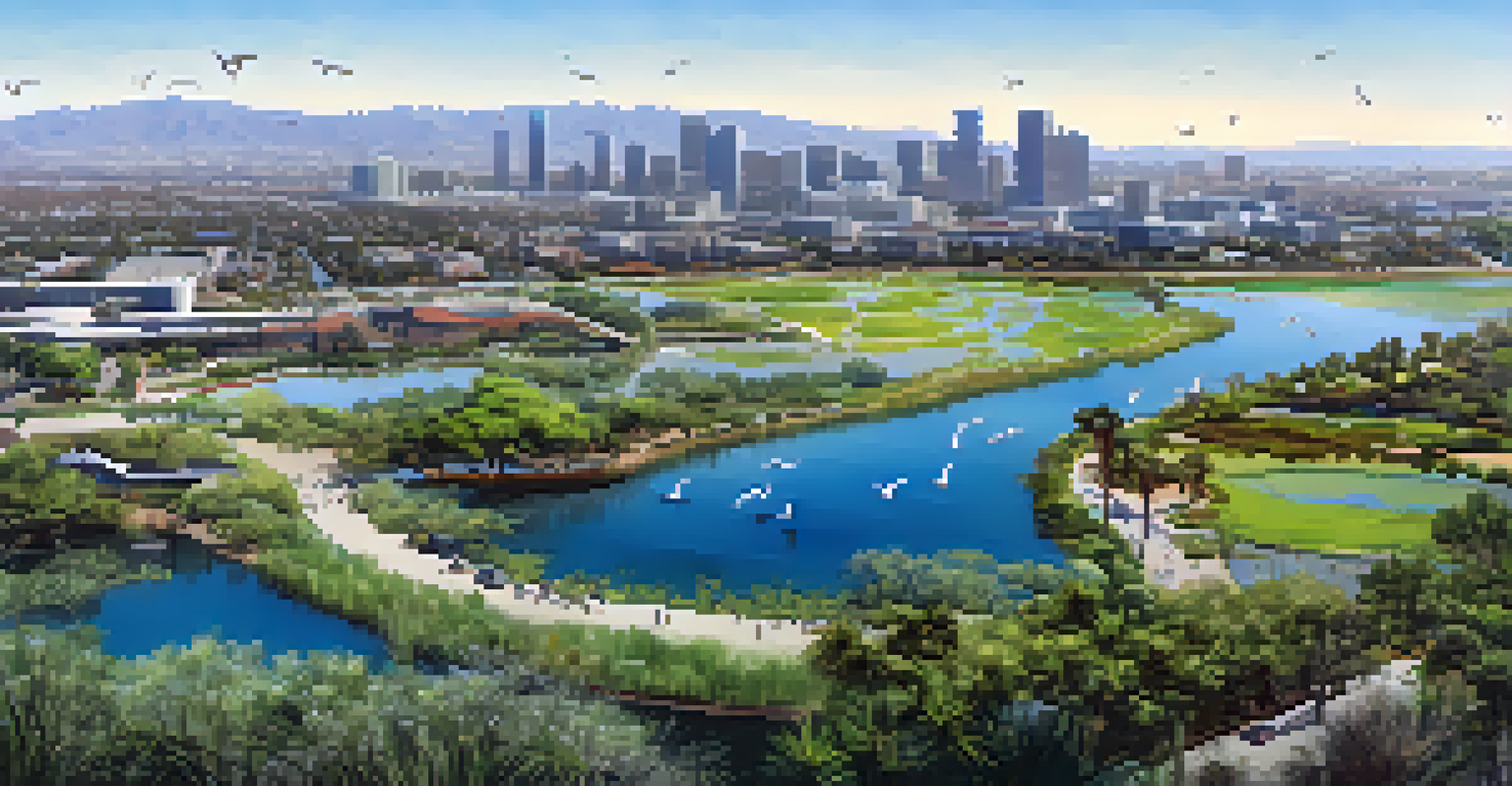Environmental Changes in Santa Monica: A Historical Review

Santa Monica's Natural Beginnings and Early Settlements
Santa Monica, originally inhabited by the Tongva people, was a land rich in natural resources. The area's coastal landscapes, with its diverse ecosystems, provided food and shelter for the indigenous population. As European settlers arrived in the 18th century, they began to alter the environment, introducing agriculture and urbanization, which set the stage for future environmental changes.
The environment is where we all meet; where we all have a mutual interest; it is the one thing all of us share.
The establishment of the Spanish mission system marked a significant shift in land use. The introduction of new crops and livestock transformed the natural landscape, leading to deforestation and changes in local wildlife habitats. These early agricultural practices laid the groundwork for the city's development and its relationship with the environment.
As the population grew, so did the demand for land and resources. The expansion of settlements during the 19th century further impacted Santa Monica's environment, leading to more significant alterations in the landscape. This period of transformation reflects the beginning of a long history of environmental change in the region.
The Rise of Urban Development in the 20th Century
The early 20th century saw rapid urbanization in Santa Monica, driven by the growth of the tourism industry and the expansion of the railroads. With its beautiful beaches and mild climate, the area became a popular destination, leading to increased construction and infrastructure development. This urban growth came at a cost to the natural environment, as wetlands were drained and coastal areas were developed.

One of the most significant changes during this period was the construction of the Santa Monica Pier in 1909, which became an iconic symbol of the city. However, this development contributed to habitat loss and increased pollution in the surrounding waters. The tensions between tourism, development, and environmental preservation began to emerge, highlighting the need for a balanced approach.
Santa Monica's Environmental Evolution
The city's development has led to significant environmental changes, reflecting a complex relationship between urbanization and natural resources.
As Santa Monica continued to evolve, the impact of urbanization on local ecosystems became increasingly apparent. Residents and officials began to recognize the importance of preserving natural spaces amid growing urban pressures, setting the stage for more sustainable practices in the following decades.
Environmental Challenges: Pollution and Coastal Erosion
With urban growth came significant environmental challenges, particularly pollution and coastal erosion. Industrial activities and increased vehicular traffic led to air and water quality issues, affecting both residents and marine life. The Santa Monica Bay, once teeming with biodiversity, faced the consequences of human activity, prompting community concerns.
We do not inherit the earth from our ancestors; we borrow it from our children.
Coastal erosion became another pressing issue, threatening the beaches that attract millions of visitors each year. Rising sea levels and extreme weather events exacerbated this problem, highlighting the vulnerability of urban coastlines. Efforts to address these challenges included beach replenishment projects and stricter pollution controls, but the struggle to maintain a healthy environment continued.
These environmental challenges prompted a shift in public awareness regarding the importance of sustainability. Local organizations and residents began to advocate for cleaner practices and policies, paving the way for a more environmentally conscious community dedicated to protecting its natural resources.
The Role of Community Activism and Environmental Policy
Community activism played a crucial role in shaping environmental policy in Santa Monica. Grassroots movements emerged in response to pollution and habitat destruction, leading to increased public engagement and advocacy for change. Local residents organized clean-up efforts, educational campaigns, and petition drives, emphasizing the importance of a healthy environment.
In response to growing environmental concerns, city officials began implementing policies aimed at sustainability. Initiatives such as the Santa Monica Sustainable City Plan established goals for reducing waste, conserving water, and promoting green building practices. These policies highlighted a commitment to protecting the environment while fostering economic growth.
Community Activism Drives Change
Grassroots movements have significantly influenced environmental policy in Santa Monica, promoting sustainability and public engagement.
The collaboration between residents, local organizations, and policymakers marked a significant turning point in Santa Monica's approach to environmental issues. This collective effort demonstrated the power of community action in driving meaningful change and shaping a more sustainable future for the city.
Restoration Efforts: Reviving Santa Monica's Natural Spaces
In recent years, there has been a revitalized focus on restoring Santa Monica's natural spaces. Various projects aim to rehabilitate coastal habitats, enhance biodiversity, and improve water quality in the Santa Monica Bay. These efforts not only benefit the local ecosystem but also provide recreational opportunities for residents and visitors alike.
One notable initiative is the restoration of the Ballona Wetlands, which supports a diverse range of wildlife. This project reflects the city's commitment to preserving natural habitats and recognizing their importance in maintaining ecological balance. Community involvement in such projects fosters a sense of stewardship and connection to the environment.
These restoration efforts signify a shift towards a more harmonious relationship with nature. By prioritizing ecological health, Santa Monica aims to create a sustainable environment that can be enjoyed by future generations, demonstrating the city's resilience and commitment to environmental stewardship.
Climate Change Impacts and Future Challenges
As climate change continues to pose significant challenges, Santa Monica is not immune to its effects. Rising temperatures, increased frequency of extreme weather events, and sea-level rise threaten the city's coastal infrastructure and ecosystems. These changes necessitate a proactive approach to climate adaptation and resilience planning.
The city has taken steps to address climate change impacts through initiatives like the Climate Action and Adaptation Plan. This comprehensive strategy outlines goals for reducing greenhouse gas emissions, enhancing coastal resilience, and increasing community awareness. By prioritizing climate action, Santa Monica aims to mitigate risks and protect its vulnerable coastal areas.
Innovative Solutions for Sustainability
Santa Monica is exploring forward-thinking initiatives to enhance sustainability, such as renewable energy and electric vehicle infrastructure.
While the challenges are substantial, they also present opportunities for innovation and collaboration. Engaging the community in climate action efforts fosters a shared responsibility for protecting the environment, reminding us that collective action is essential in facing the realities of climate change.
Innovative Solutions for a Sustainable Future
Looking ahead, Santa Monica is exploring innovative solutions to promote sustainability and environmental resilience. Initiatives like smart city technologies, renewable energy projects, and sustainable transportation options are shaping the future of urban living. These forward-thinking approaches aim to reduce the city's carbon footprint while enhancing the quality of life for residents.
One exciting development is the push for electric vehicle infrastructure, encouraging the use of clean transportation options. By investing in charging stations and promoting public transit, Santa Monica is working to reduce traffic congestion and improve air quality. These efforts reflect a commitment to creating a greener, more sustainable urban environment.

As Santa Monica navigates the complexities of environmental change, the focus on innovation and community engagement will be crucial. By embracing new technologies and sustainable practices, the city can lead by example, inspiring other communities to prioritize environmental stewardship and work towards a more sustainable future.